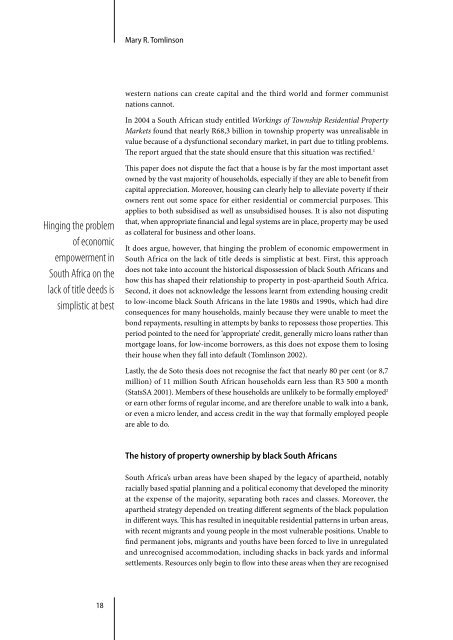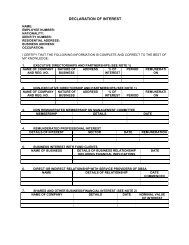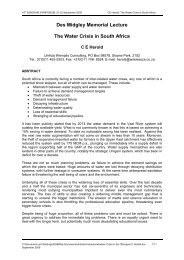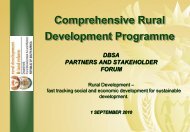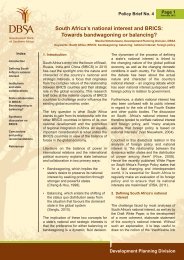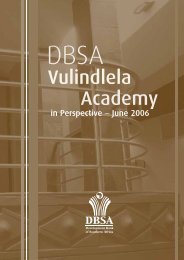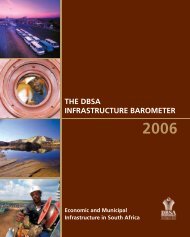Are Hernando de Soto's views appropriate to South Africa?
Are Hernando de Soto's views appropriate to South Africa?
Are Hernando de Soto's views appropriate to South Africa?
You also want an ePaper? Increase the reach of your titles
YUMPU automatically turns print PDFs into web optimized ePapers that Google loves.
Mary R. Tomlinson<br />
western nations can create capital and the third world and former communist<br />
nations cannot.<br />
In 2004 a <strong>South</strong> <strong>Africa</strong>n study entitled Workings of Township Resi<strong>de</strong>ntial Property<br />
Markets found that nearly R68,3 billion in <strong>to</strong>wnship property was unrealisable in<br />
value because of a dysfunctional secondary market, in part due <strong>to</strong> titling problems.<br />
The report argued that the state should ensure that this situation was rectified. 1<br />
Hinging the problem<br />
of economic<br />
empowerment in<br />
<strong>South</strong> <strong>Africa</strong> on the<br />
lack of title <strong>de</strong>eds is<br />
simplistic at best<br />
This paper does not dispute the fact that a house is by far the most important asset<br />
owned by the vast majority of households, especially if they are able <strong>to</strong> benefit from<br />
capital appreciation. Moreover, housing can clearly help <strong>to</strong> alleviate poverty if their<br />
owners rent out some space for either resi<strong>de</strong>ntial or commercial purposes. This<br />
applies <strong>to</strong> both subsidised as well as unsubsidised houses. It is also not disputing<br />
that, when <strong>appropriate</strong> financial and legal systems are in place, property may be used<br />
as collateral for business and other loans.<br />
It does argue, however, that hinging the problem of economic empowerment in<br />
<strong>South</strong> <strong>Africa</strong> on the lack of title <strong>de</strong>eds is simplistic at best. First, this approach<br />
does not take in<strong>to</strong> account the his<strong>to</strong>rical dispossession of black <strong>South</strong> <strong>Africa</strong>ns and<br />
how this has shaped their relationship <strong>to</strong> property in post-apartheid <strong>South</strong> <strong>Africa</strong>.<br />
Second, it does not acknowledge the lessons learnt from extending housing credit<br />
<strong>to</strong> low-income black <strong>South</strong> <strong>Africa</strong>ns in the late 1980s and 1990s, which had dire<br />
consequences for many households, mainly because they were unable <strong>to</strong> meet the<br />
bond repayments, resulting in attempts by banks <strong>to</strong> repossess those properties. This<br />
period pointed <strong>to</strong> the need for ‘<strong>appropriate</strong>’ credit, generally micro loans rather than<br />
mortgage loans, for low-income borrowers, as this does not expose them <strong>to</strong> losing<br />
their house when they fall in<strong>to</strong> <strong>de</strong>fault (Tomlinson 2002).<br />
Lastly, the <strong>de</strong> So<strong>to</strong> thesis does not recognise the fact that nearly 80 per cent (or 8,7<br />
million) of 11 million <strong>South</strong> <strong>Africa</strong>n households earn less than R3 500 a month<br />
(StatsSA 2001). Members of these households are unlikely <strong>to</strong> be formally employed 2<br />
or earn other forms of regular income, and are therefore unable <strong>to</strong> walk in<strong>to</strong> a bank,<br />
or even a micro len<strong>de</strong>r, and access credit in the way that formally employed people<br />
are able <strong>to</strong> do.<br />
The his<strong>to</strong>ry of property ownership by black <strong>South</strong> <strong>Africa</strong>ns<br />
<strong>South</strong> <strong>Africa</strong>’s urban areas have been shaped by the legacy of apartheid, notably<br />
racially based spatial planning and a political economy that <strong>de</strong>veloped the minority<br />
at the expense of the majority, separating both races and classes. Moreover, the<br />
apartheid strategy <strong>de</strong>pen<strong>de</strong>d on treating different segments of the black population<br />
in different ways. This has resulted in inequitable resi<strong>de</strong>ntial patterns in urban areas,<br />
with recent migrants and young people in the most vulnerable positions. Unable <strong>to</strong><br />
find permanent jobs, migrants and youths have been forced <strong>to</strong> live in unregulated<br />
and unrecognised accommodation, including shacks in back yards and informal<br />
settlements. Resources only begin <strong>to</strong> flow in<strong>to</strong> these areas when they are recognised<br />
18


